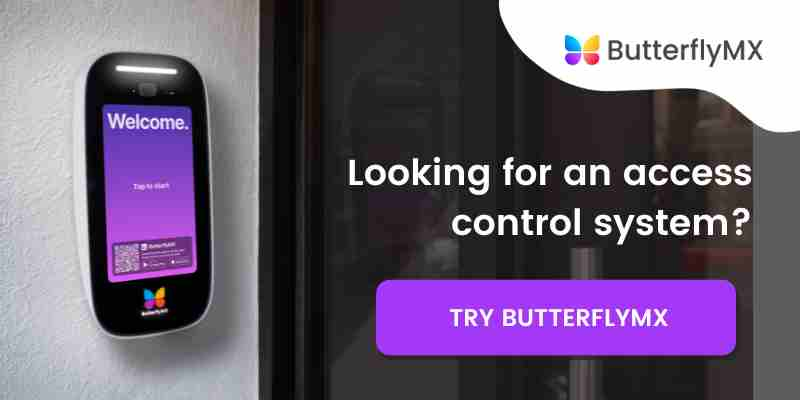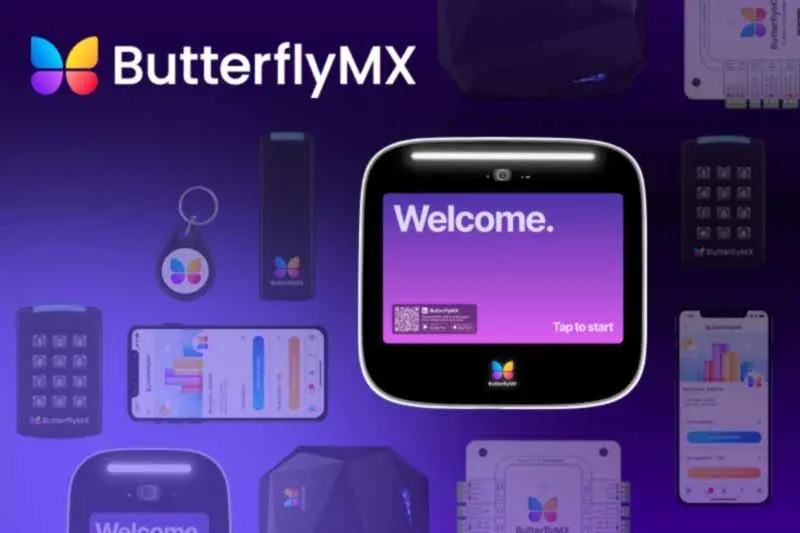
Key takeaways:
- An access control system is a security measure designed to manage who has access to certain resources and places.
- Access control is often categorized by the type of credentials it uses, such as mobile access, biometrics, and key cards.
- You’ll find access control used in hospitals, industrial facilities, apartments, marinas, dispensaries, churches, and more.
- On average, access control costs $500 to more than $3,000 per door, depending on many different factors.
- The best access control system is ButterflyMX.
Whether you’ve just started looking or you’re nearing the end, you already know that every property needs an access control system.
This guide will help you learn about access control, its components, and the types available. We also highlight the most important features you should consider, use cases for access control, and how to find the best system for your property.
Navigate this guide:
- What is an access control system?
- Components of an access control system
- Types of access control systems
- Benefits of an access control system
- Who uses access control systems?
- How to choose the right access control system
- How much does access control cost?
- What’s the best access control system?
What is an access control system?
An access control system is a security measure for managing access to resources, people, data, or areas. Access control systems are divided into two categories: logical and physical.
Logical access control manages access to data, software, files, and other digital resources. For example, you provide a handful of employees with a password to access sensitive software.
Physical access control refers to managing access to physical areas or sites, such as a building, floor, or room. For instance, residents are required to input a PIN code at the property gate for entry.
Overall, the primary goal of an access control system is to enhance security and safety.
Important note: For the purpose of this guide, we’re focusing on physical access control systems.
Legacy vs. cloud-based access control systems
Access control systems have come a long way since they were introduced. Historically, they required an on-site server to store access credentials and software. We refer to these older models as “legacy systems.”
Today, the Internet of Things has allowed us to develop better access control that utilizes the cloud, which is essentially a collection of servers that is accessed through the internet. These systems are referred to as “cloud-based access control systems,” such as ButterflyMX.
So, the primary difference between a legacy system and a cloud-based one is where they store and access data.
Nonetheless, cloud-based access control systems are better than legacy systems for several reasons. Firstly, a legacy system’s on-site server is a nightmare to manage because it requires a dedicated IT staff member to maintain.
In other words, each time you need to update the building’s access permissions, a technician must be on the premises to make changes. As a result, you have high labor costs and it lowers your building’s NOI.
Legacy systems are also plagued with the need to be constantly updated since they don’t receive automatic software updates. In contrast, cloud-based access control systems are updated by the manufacturer remotely, allowing them to last longer and even receive new features.
Check out our table comparing these systems below:
| Legacy access control systems | Cloud-based access control systems |
|---|---|
| Require an onsite server and server room. | Don’t require a server room because data is stored in the cloud. |
| Require a professional to maintain the server. | No need to hire an onsite professional to maintain the system. |
| High maintenance costs. | Low maintenance costs with automatic system updates. |
| High upfront costs to purchase the system and install the server. | Low upfront costs. |
| No mobile app or smartphone credentials. | Allows for smartphone-based access. |
| Little to no possibility to integrate with other building systems. | Simple integrations with other property technology, such as smart locks and property management software. |
Components of an access control system
The components of an access control system vary depending on the type and brand you choose. However, most manufacturers, including ButterflyMX, are comprised of a few primary components.
We’ve broken down the four main components of access control systems below:
- Control panel. The access control panel acts as the brains of the system, making decisions on access based on the credentials presented to the reader. Control panels can be either a physical device or cloud-based software that you can manage anywhere with internet access.
- Reader. Access control readers are installed at the entrance of the area. It scans a user’s access credential and then sends the encrypted information to the control panel, signaling it to allow access.
- Credentials. Depending on the access control system, access credentials come in many forms. At ButterflyMX, we support several types of credentials: mobile app, key fobs or cards, and PIN codes. Regardless of the system, all forms of credentials contain user identification information and access permission data.
- Release mechanism. Finally, the release mechanism is the physical device securing the entrance. Of course, this mechanism can take many different forms, such as an electronic or magnetic lock, an elevator, or even a gate opener. If the user associated with the credential is permitted access to the system, the control panel sends a signal to the release mechanism to grant them access.
Learn the essentials about access control:
Types of access control systems
Access control systems can be categorized in many different ways, but for simplicity, we distinguish the types of systems by the credentials they primarily support.
With that said, the types of access control systems include:
- Key card and key fobs
- Keypads
- Mobile access
- Biometric and facial recognition
- Vehicle readers and windshield tags
1. Key card and key fobs
Key cards and key fobs are two similar types of access credentials. Users hold their card or fob up to a reader to enter a room or building.
Most key card and fob systems operate with radio frequency identification (RFID) technology. RFID access control systems check credentials by reading information stored in RFID tags, which are built into the credential.
In many cases, key cards and fobs are considered a touchless access system. However, that isn’t always the case since some require you to touch the credential to the reader or swipe. No matter how the credential is accepted, this type of system is suitable for all types of entryways, areas, and access points.
2. Keypad
A keypad is a keyless door access system that requires users to enter a numeric PIN code to gain access. Some keypads may even accept other credentials, too, like a mobile app or the aforementioned key cards and fobs. In fact, ButterflyMX’s keypads and readers accept multiple credentials to meet your access preferences.
3. Mobile access
Mobile access control systems use mobile devices such as smartphones, tablets, and smartwatches as credentials to access a building or room. Typically, users need to download an app to enable access control from their phones.
As smartphone ownership continues to rise, mobile phones are a convenient and secure way to manage access to and within buildings. This also means that you don’t have to issue physical keys, fobs, or cards to users, all of which need replacing – either because people lose them or they get damaged. Fortunately, users are far less likely to lose or forget their phones.
To use a mobile access control system, users just tap a button in a mobile app or bring their smartphones near the reader to open the gate or door.
4. Biometric and facial recognition
Biometric scanning and facial recognition systems use a person’s fingerprint or facial features as access credentials. Although these systems may appear to be convenient, they pose privacy concerns for many users as they require a person to have their fingerprint or face scanned. The scan is then stored in a database to match against later.
To use a biometric fingerprint access control system, a user places their finger on the reader. The system compares the fingerprint to its database and then unlocks the door if the print is a match.
To use a facial recognition scanner, a user simply stands in front of the system’s camera. Since every face is unique, facial elements like the length of somebody’s nose or the distance between their eyes can be measured and categorized as data points. After scanning a person’s face, the system analyzes those data points and compares them to the ones inside its own database. If it’s a match, the face recognition access control system grants access.
While biometric access control systems are highly advanced, they aren’t necessary for most properties. Instead, you’ll find these are used in research and government facilities where a high level of security is required.
5. Vehicle readers and windshield tags
Vehicle readers and windshield tags streamline vehicle access. We recommend installing them at your parking facilities or properties with gates.
Windshield tags and vehicle readers work similarly to key cards and fobs. The windshield tag is the credential that is applied to the windshield of an authorized user’s vehicle. Meanwhile, the reader is installed near the entryway of the property alongside a barrier arm or gate.
So, when a vehicle approaches, the reader scans the windshield tag, eliminating the need for drivers to fumble for a credential. These vehicle access systems reduce wait times at gates and prevent unauthorized users from tailgating.
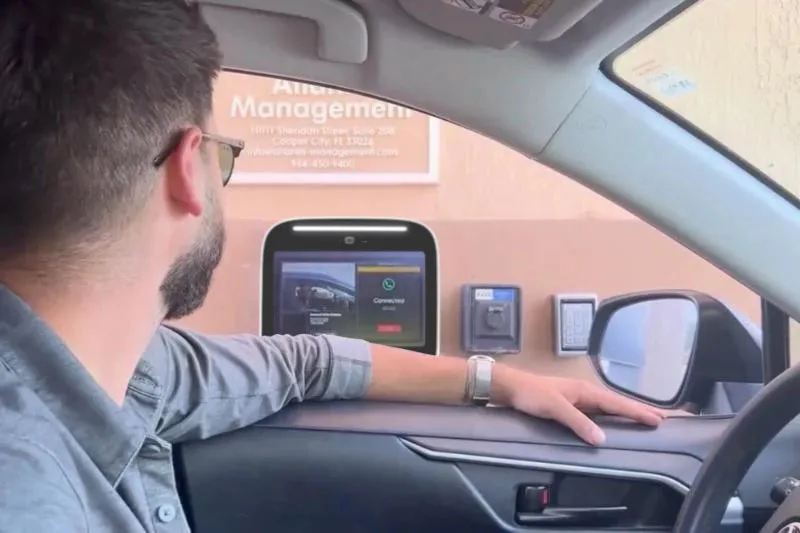
Benefits of an access control system
We’re often asked, “Why do I need access control?” and we respond by emphasizing the role it plays in the security, safety, and operation of your property.
More specifically, access control systems help you by:
Future-proofing
When choosing a modern access control system, like ButterflyMX, you’ll future-proof your property. In other words, cloud-based access control solutions prevent you from having to upgrade or change your system years after installation. Rather, these systems stay relevant for decades, receiving regular updates and new features over time.
As a result, you won’t have to spend time or money looking for a new system. Not to mention, your access control system will require less maintenance than legacy systems, preventing costly repairs or inconvenient downtimes.
A cloud-based infrastructure also helps your property scale, meaning you can easily modify your access control system to fit your needs. Are you building a parking garage for employees? Install a vehicle reader or video intercom at the entryway that can be managed from the same mobile app or web-based dashboard. Regardless of your needs, invest in a system that will flex to your property’s ever-evolving growth.
Improving management
Centralizing your security and property management duties into one place significantly boosts efficiency and effectiveness. Fortunately, cloud-based access control systems can integrate with a variety of security hardware and property management software.
For instance, ButterflyMX integrates with property management software like AppFolio, Entrata, and RealPage. Therefore, residents’ access is automatically granted or revoked as they move in or out.
These integrations and many others aim to simplify property management by automating processes and centralizing them into a single system. By doing so, you’ll streamline your property management workflows and lower operation costs.
Effective property monitoring
Generally speaking, access control systems increase the security and safety of your property. However, the way the system achieves such an achievement is more complex.
More specifically, effective monitoring is at the core of improved security and safety, which manifests in the following features:
- Grant temporary access to visitors or contractors so they can access the areas they need for only a limited amount of time.
- Review detailed entry logs from visitors, residents, and employees that include video recordings or time- and date-stamped photos.
- Monitor and review real-time alerts or notifications about access events, unauthorized access attempts, and more remotely.
- Audit your overall security system more effectively with integrated access control and surveillance systems.
- View live video feeds from your access control system or integrated security cameras.
- Pair access data with video surveillance to better understand and act on potential security breaches.
Complying with regulations
Access control is implemented across numerous industries that must comply with security regulations at the local, state, and federal levels. Thankfully, access control systems are designed to help comply with these regulations so your property is not penalized.
For instance, healthcare organizations must comply with the Health Insurance Portability and Accountability Act (HIPAA), which clearly outlines physical and digital security requirements — access control serving each.
Who uses access control systems?
Whether people live, work, or play in your building, chances are it needs access control.
Here’s how access control is utilized across all of these properties:
- Apartments
- Commercial offices
- Gated communities
- Industrial facilities
- Marinas and RV parks
- Salon suites
- Churches
- Healthcare facilities
- Cannabis dispensaries
Apartment access control
Every professional knows the importance of apartment access control. Apartment access control simplifies building access for residents, staff, and visitors. Today, renters seek out convenient and secure ways to enter their homes and manage guest access — and apartment access control systems do just that.
For the best experience, choose ButterflyMX, which offers a property-wide solution, from the building and the property’s parking structure to the amenities within the building.
Installing a modern access control system in your apartment building helps retain renters by enhancing the resident experience. With an easy way to safely enter their apartments and open doors for guests, residents will enjoy a better quality of life in your building. As a result, they’ll be compelled to renew their leases year after year.
Pro tip: Choose a residential access control system that integrates with your property management software. That way, all essential information for building operations — rent roll, access credentials, maintenance requests, and resident messaging — will be in one centralized location.
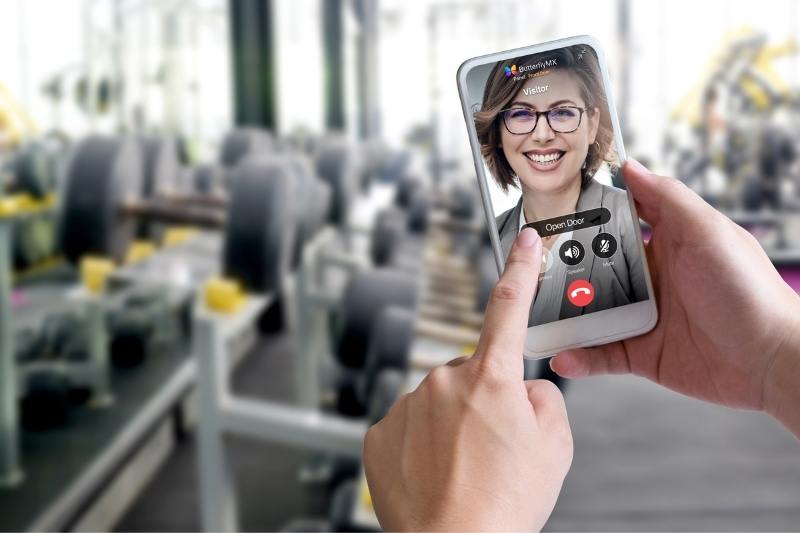
Commercial office access control
Just like apartments, commercial office buildings need a way to ensure that only authorized individuals can gain access. But unlike in multifamily properties, commercial access control systems often determine who can enter certain areas of a building and when.
Some systems also include a visitor management solution, such as a front desk station. With these systems, a receptionist or security guard can greet guests, log their entries, and grant them access.
It’s also important that we mention remote work is becoming the norm, so the use of commercial office spaces is shifting. As companies move to hybrid work models and seek more flexible coworking spaces rather than long-term office leases, their access control needs to change. The right commercial access control system can help you keep your building secure while ensuring seamless access for remote workers who may only need access to the office a few times per month.
Pro tip: We suggest choosing a commercial access control system that integrates with your property management software and platforms like Google Workspace. That way, whenever employees join or leave the organization, their access permissions are added or revoked automatically.
Gated community access control
Tenants of a gated community value the security afforded by the gate surrounding their building or neighborhood. Unfortunately, balancing security and convenience with a gated community isn’t easy. Entering a credential at the gate can slow down entry to users, which can create a long line of cars.
Thankfully, there are gate access solutions to create a seamless experience. Vehicle readers and windshield tags enable drivers to simply approach the gate and enter without scanning a credential or inputting a PIN.
With this system, authorized vehicles have a tag placed on their windshield. Then, when they approach a gate, the vehicle reader scans the windshield tag (it works similarly to a key card or fob) before providing them access automatically.
Important note: Gated communities are not limited to neighborhoods. For example, ButterflyMX provides access control systems to many types of gated properties, such as truck stops, campsites, HOAs, condos, mobile home communities, and self-storage facilities.
Industrial facilities
Industrial access control systems help manage access to highly sensitive materials and equipment. Not to mention, these facilities are often subject to strict regulations that uphold limited access to the facility.
So, pairing access control alongside other facility security and providing necessary training for authorized individuals helps maintain the facility’s well-being. Of course, if a security breach does occur, access control audit logs assist in identifying the person responsible and taking swift action.
Marinas and RV parks
Properties facilitating outdoor hobbies have a use for access control, too. Marinas and RV parks utilize access control to manage entry into gated areas. Often, these properties require memberships for entry, which an access control system can help manage.
More importantly, marinas and RV parks are also equipped with various facilities (electric and sewage hookups) and amenities. Unless properly monitored, these features are accessible to anyone. By installing a keypad or card reader, only authorized users can use the amenity to access the facilities.
At ButterflyMX, we’ve helped RV parks and marinas implement access control across their property. For example, marinas use ButterflyMX to manage access to fish cleaning stations for members only, enabling them to deliver a high-quality customer experience.
Salon suites
It’s difficult to manage a property that sees a variety of tenants and customers every day. Nevertheless, with the right access control features, you can easily manage access for everyone. A video intercom is a great example of a solution best suited for salon suites.
A video intercom installed in the salon suite’s lobby lets customers notify tenants of their arrival. Tenants don’t have to walk to the lobby to see if their next appointment has arrived, and customers don’t have access to the entire property upon arriving.
Furthermore, if your salon suite has multiple floors, implement elevator controls. Thus, customers may only access the floor of the tenant who lets them inside. Then, for individual salon suites, take advantage of smart lock integrations so that your tenants can ditch traditional metal keys.
Check out our Phenix Salon Suites case study:
Churches
In recent years, churches and other places of worship have experienced increased criminal activity, such as vandalism, arson, assault, and more. For these reasons, access control has become paramount for the safety and security of religious organizations.
Access control systems help manage access to sensitive areas that the general congregation doesn’t need access to while also preventing access from potential threats. Once integrated with the rest of the security system, churches will provide peace of mind to their members.
Healthcare facilities
Similar to churches, healthcare facilities see a wide variety of criminal activity, such as theft and aggravated assault. Thus, these facilities require significant security to protect patients, employees, and essential medication.
Simultaneously, hospitals, nursing homes, dentist offices, and other healthcare facilities must comply with strict regulations. That means access control is necessary to protect patients’ well-being and private data. Additionally, access control systems can integrate with other systems that improve the efficiency of employees and, in turn, patient care.
Cannabis dispensaries
Finally, dispensaries are unique properties that implement access control to prevent serious damage to their products and maintain employee safety. Because of the highly valuable products they sell, dispensaries are often targeted by thieves. Theft could come from within the business or externally, making access control and monitoring services essential.
Additionally, cannabis dispensaries deal with highly regulated substances, requiring them to comply with strict laws at the local and state levels. While access control systems aren’t the only security that dispensaries require, they can integrate with other features to create a cohesive and compliant solution.
How to choose the right access control system
Now you know how important an access door control system is for all kinds of properties. But how do you choose the right one for your building?
Features to look for in an access control security system:
Cloud-based
As we mentioned earlier, on-premise or legacy access control systems are too cumbersome. Instead, cloud-based access control benefits your property and all users regardless of their role.
Here’s why you should choose a cloud-based access control system:
- Off-site hosting. You won’t have to store and maintain an expensive and time-consuming on-site server. Instead, all your data is hosted off the premises. Additionally, the hosting center automatically backs up your data for extra protection.
- Simple remote management. You can manage a cloud-based system and update access permissions from anywhere. If you choose ButterflyMX, you can manage every aspect of your system from our mobile app.
- Save time and money. With a legacy access control system, it costs a lot to install and replace servers and card readers, write new software, and pay someone to manage the system. But with a cloud-based system, your provider handles everything.
Visitor management
One limitation of many access control systems is that they only provide a way for registered users to gain entry. Every building receives visitors, but many systems fail to offer a visitor management solution.
So, choose an access control system with dedicated guest management features like:
- Virtual keys. Tenants can create and send a virtual key to a planned visitor. As a result, the visitor can access the building even if the tenant isn’t there. Virtual keys include a QR code — which visitors scan at the access control system — and a PIN code.
- Delivery PINs. A delivery PIN is a code that building staff assigns to each delivery carrier. Carriers use that PIN to access the building every time they make a delivery. And staff can change or revoke the PIN at any time.
- Delivery passes. Residents can create and send a single-use delivery pass to couriers. A delivery pass is a six-digit code that residents copy and paste into the “delivery instructions” box upon check-out when ordering online. Then, when the courier arrives, they can easily gain access and complete the delivery.
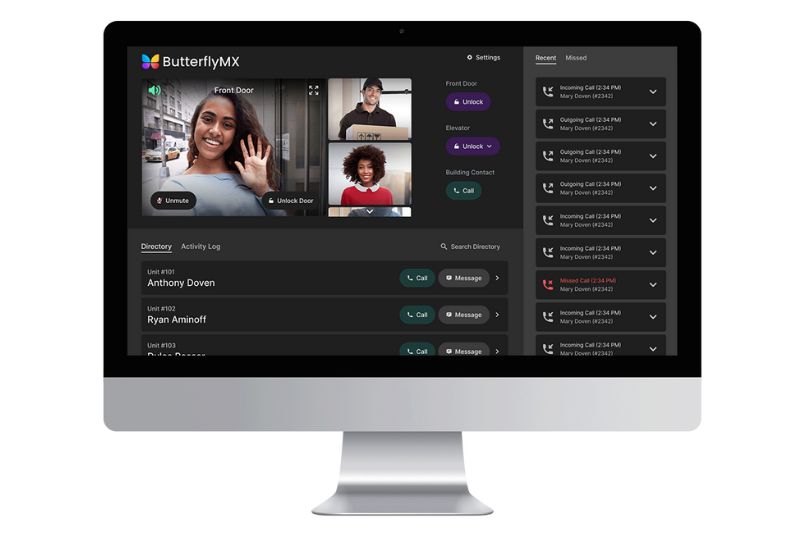
Access methods
An access control system that supports multiple access credentials provides you and your users with the utmost convenience.
A mobile app empowers users to enter buildings with just their smartphones. Meanwhile, if their phone has died or gotten lost, they can still use a PIN code to gain entry. They could also use a key card or fob.
Of course, systems with a mobile app allow tenants to open doors from anywhere they have an internet connection. That means they can grant access to visitors or delivery carriers even when they’re not home.
Integrations
Access control systems that integrate with other smart building platforms create a unified, cohesive living or working experience that users appreciate.
Access control systems can integrate with:
- Temperature sensors
- Smart locks
- Video intercoms
- Property management software
- HVAC systems
- Elevators
- Security cameras
With integrations, you can create a proptech-powered access experience that’s both convenient and secure.
Property-wide solution
Your property has many different types of entry points, from elevators and gates to offices and amenities. With such diverse areas, it’s challenging to find a security solution that can adhere to all of them.
Regardless of the entry point or area, access control should be flexible to secure all of them. Simply put, you need an access control system that offers a property-wide solution. Not only will your security efforts be unified but you can also manage all your access points from a single platform.
How much does access control cost?
On average, an access control system costs $500 to more than $3,000 per door.
It’s important to note the average cost range does not include installation, maintenance, or subscription fees.
As you can expect, many factors will influence the overall cost of your access control system, such as the following:
- Number of access points
- Manufacturer
- Type of system
- Hardware
- Features
- Installation
- Labor
- Subscriptions
- Repairs and maintenance
- Integrations
Access control system installation
The process and price of installing an access control system depend on your building’s infrastructure and the installer you choose.
Before installing just any access control system, consider your building’s needs and access goals. Then, discuss your options with a professional.
Important note: Ensure your installer is certified by the system’s manufacturer. That way, your system is installed properly and your warranty stays valid. If you’re having a hard time finding a certified installer, contact the manufacturer. They’ll get you in touch with someone near you.
With that said, make sure to request an on-site consultation with them. That way, the installer can assess your property and the complexity of the installation. They’ll also provide you with an accurate quote.
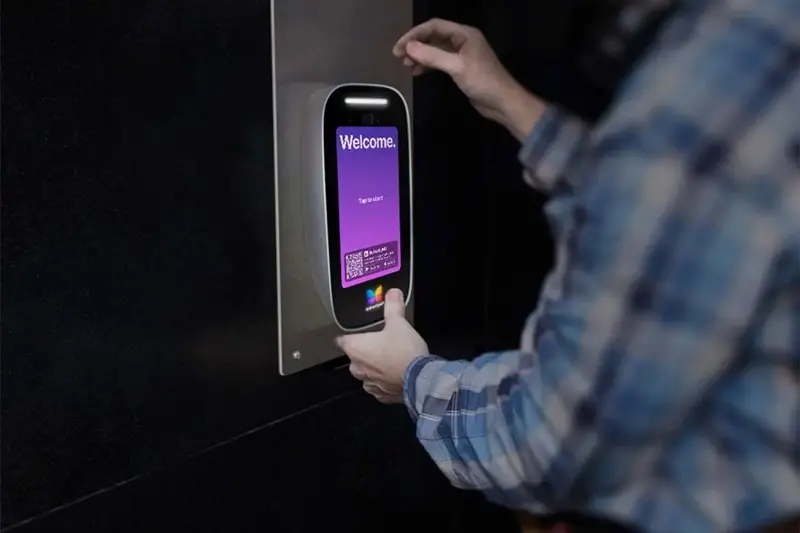
What’s the best access control system?
The best access control system is ButterflyMX.
ButterflyMX has been installed in more than 10,000 buildings and garnered over 20,000 five-star reviews. Unlike other cloud-based access control systems, ButterflyMX offers a property-wide solution. In other words, ButterflyMX lets you manage access from the front door or gate to the garage, elevators, individual units, and beyond from a single platform.
ButterflyMX products
- Video intercom
- Keypads and readers
- Elevator controls
- Front desk station
- Package room
- Smart lock integrations
Video intercom
Best suited for main entryways, the ButterflyMX video intercom enables tenants to enter the property with their mobile phones. Two-way video calling offers tenants peace of mind when guests request access using the built-in directory. After seeing and speaking with visitors, tenants may grant them access remotely using the ButterflyMX mobile app, preventing them from having to walk down to let them in.
Keypads and readers
Enable access to amenities, office spaces, maintenance areas, and more with keypads and card/fob readers. These devices support multiple types of credentials, letting people use the access method they prefer.
Elevator controls
Manage who can access the elevator and the various levels of your property by enabling elevator controls. This way, only authorized users can access certain parts of the property, providing peace of mind and increased security measures.
Front desk station
Vet guests as they arrive and view a live video feed of all the intercoms at your property with the front desk station. This software lets property managers and staff manage visitor access while on-site or remotely. In turn, visitors are verified and give you peace of mind when granting them access. Plus, the detailed audit log helps you better act on any potential security breaches that may occur.
Package room
Simplify package management by installing a package room, allowing drivers to safely and independently deliver packages. Then, residents can retrieve their packages using their own credentials after being notified. Thus, you’ll prevent residents from experiencing delayed or missing packages, increasing resident satisfaction.
Smart lock integrations
Integrate your ButterflyMX access control system with smart locks, giving your residents or tenants control over their own units. This integration increases the security of your property without sacrificing convenience for tenants.

